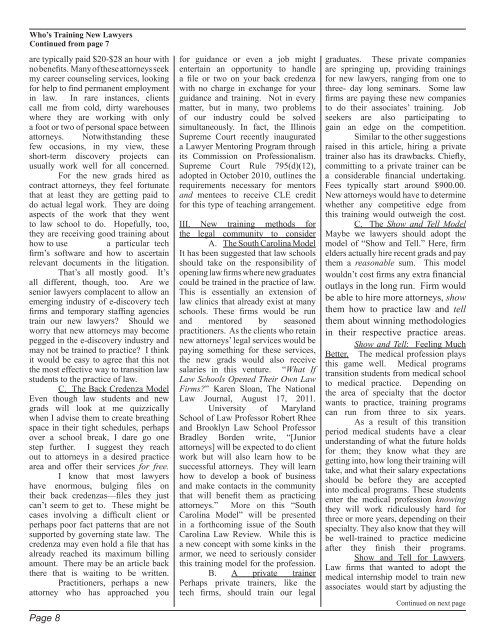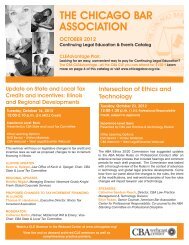ALLIANCE NEWS - The Chicago Bar Association
ALLIANCE NEWS - The Chicago Bar Association
ALLIANCE NEWS - The Chicago Bar Association
You also want an ePaper? Increase the reach of your titles
YUMPU automatically turns print PDFs into web optimized ePapers that Google loves.
Who’s Training New Lawyers<br />
Continued from page 7<br />
are typically paid $20-$28 an hour with<br />
no benefits. Many of these attorneys seek<br />
my career counseling services, looking<br />
for help to find permanent employment<br />
in law. In rare instances, clients<br />
call me from cold, dirty warehouses<br />
where they are working with only<br />
a foot or two of personal space between<br />
attorneys. Notwithstanding these<br />
few occasions, in my view, these<br />
short-term discovery projects can<br />
usually work well for all concerned.<br />
For the new grads hired as<br />
contract attorneys, they feel fortunate<br />
that at least they are getting paid to<br />
do actual legal work. <strong>The</strong>y are doing<br />
aspects of the work that they went<br />
to law school to do. Hopefully, too,<br />
they are receiving good training about<br />
how to use a particular tech<br />
firm’s software and how to ascertain<br />
relevant documents in the litigation.<br />
That’s all mostly good. It’s<br />
all different, though, too. Are we<br />
senior lawyers complacent to allow an<br />
emerging industry of e-discovery tech<br />
firms and temporary staffing agencies<br />
train our new lawyers? Should we<br />
worry that new attorneys may become<br />
pegged in the e-discovery industry and<br />
may not be trained to practice? I think<br />
it would be easy to agree that this not<br />
the most effective way to transition law<br />
students to the practice of law.<br />
C. <strong>The</strong> Back Credenza Model<br />
Even though law students and new<br />
grads will look at me quizzically<br />
when I advise them to create breathing<br />
space in their tight schedules, perhaps<br />
over a school break, I dare go one<br />
step further. I suggest they reach<br />
out to attorneys in a desired practice<br />
area and offer their services for free.<br />
I know that most lawyers<br />
have enormous, bulging files on<br />
their back credenzas—files they just<br />
can’t seem to get to. <strong>The</strong>se might be<br />
cases involving a difficult client or<br />
perhaps poor fact patterns that are not<br />
supported by governing state law. <strong>The</strong><br />
credenza may even hold a file that has<br />
already reached its maximum billing<br />
amount. <strong>The</strong>re may be an article back<br />
there that is waiting to be written.<br />
Practitioners, perhaps a new<br />
attorney who has approached you<br />
Page 8<br />
for guidance or even a job might<br />
entertain an opportunity to handle<br />
a file or two on your back credenza<br />
with no charge in exchange for your<br />
guidance and training. Not in every<br />
matter, but in many, two problems<br />
of our industry could be solved<br />
simultaneously. In fact, the Illinois<br />
Supreme Court recently inaugurated<br />
a Lawyer Mentoring Program through<br />
its Commission on Professionalism.<br />
Supreme Court Rule 795(d)(12),<br />
adopted in October 2010, outlines the<br />
requirements necessary for mentors<br />
and mentees to receive CLE credit<br />
for this type of teaching arrangement.<br />
III. New training methods for<br />
the legal community to consider<br />
A. <strong>The</strong> South Carolina Model<br />
It has been suggested that law schools<br />
should take on the responsibility of<br />
opening law firms where new graduates<br />
could be trained in the practice of law.<br />
This is essentially an extension of<br />
law clinics that already exist at many<br />
schools. <strong>The</strong>se firms would be run<br />
and mentored by seasoned<br />
practitioners. As the clients who retain<br />
new attorneys’ legal services would be<br />
paying something for these services,<br />
the new grads would also receive<br />
salaries in this venture. “What If<br />
Law Schools Opened <strong>The</strong>ir Own Law<br />
Firms?” Karen Sloan, <strong>The</strong> National<br />
Law Journal, August 17, 2011.<br />
University of Maryland<br />
School of Law Professor Robert Rhee<br />
and Brooklyn Law School Professor<br />
Bradley Borden write, “[Junior<br />
attorneys] will be expected to do client<br />
work but will also learn how to be<br />
successful attorneys. <strong>The</strong>y will learn<br />
how to develop a book of business<br />
and make contacts in the community<br />
that will benefit them as practicing<br />
attorneys.” More on this “South<br />
Carolina Model” will be presented<br />
in a forthcoming issue of the South<br />
Carolina Law Review. While this is<br />
a new concept with some kinks in the<br />
armor, we need to seriously consider<br />
this training model for the profession.<br />
B. A private trainer<br />
Perhaps private trainers, like the<br />
tech firms, should train our legal<br />
graduates. <strong>The</strong>se private companies<br />
are springing up, providing trainings<br />
for new lawyers, ranging from one to<br />
three- day long seminars. Some law<br />
firms are paying these new companies<br />
to do their associates’ training. Job<br />
seekers are also participating to<br />
gain an edge on the competition.<br />
Similar to the other suggestions<br />
raised in this article, hiring a private<br />
trainer also has its drawbacks. Chiefly,<br />
committing to a private trainer can be<br />
a considerable financial undertaking.<br />
Fees typically start around $900.00.<br />
New attorneys would have to determine<br />
whether any competitive edge from<br />
this training would outweigh the cost.<br />
C. <strong>The</strong> Show and Tell Model<br />
Maybe we lawyers should adopt the<br />
model of “Show and Tell.” Here, firm<br />
elders actually hire recent grads and pay<br />
them a reasonable sum. This model<br />
wouldn’t cost firms any extra financial<br />
outlays in the long run. Firm would<br />
be able to hire more attorneys, show<br />
them how to practice law and tell<br />
them about winning methodologies<br />
in their respective practice areas.<br />
Show and Tell: Feeling Much<br />
Better. <strong>The</strong> medical profession plays<br />
this game well. Medical programs<br />
transition students from medical school<br />
to medical practice. Depending on<br />
the area of specialty that the doctor<br />
wants to practice, training programs<br />
can run from three to six years.<br />
As a result of this transition<br />
period medical students have a clear<br />
understanding of what the future holds<br />
for them; they know what they are<br />
getting into, how long their training will<br />
take, and what their salary expectations<br />
should be before they are accepted<br />
into medical programs. <strong>The</strong>se students<br />
enter the medical profession knowing<br />
they will work ridiculously hard for<br />
three or more years, depending on their<br />
specialty. <strong>The</strong>y also know that they will<br />
be well-trained to practice medicine<br />
after they finish their programs.<br />
Show and Tell for Lawyers.<br />
Law firms that wanted to adopt the<br />
medical internship model to train new<br />
associates would start by adjusting the<br />
Continued on next page




